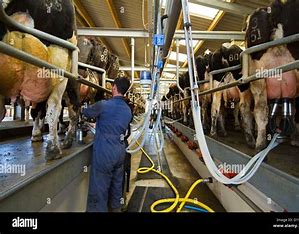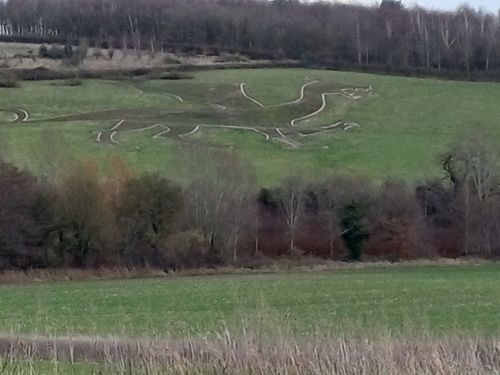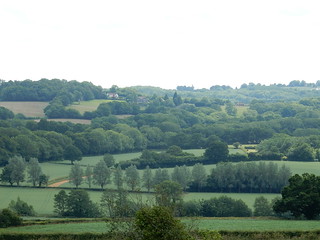Today is a walk of two halves. First a pleasant stroll along the shore of the Dee Estuary, followed by a slog along the roads beyond Flint. But, let’s start with the good part.
The tide is high when I reach Greenfield Dock, and this morning the little boats are afloat instead of stranded in the mud.

I set off walking southeasterly, following the shore. Flintshire County Council have spruced up this area and there’s a good tarmac path running along the side of the water, along with seats, information boards, and a giant wooden clam shell.

Once the River Dee was so polluted by heavy industry that it was, effectively, a dead zone. Now, after the loss of the industries – and a prolonged period of clean-up – the river is flourishing once more. This area is now called the Dee Estuary Nature Reserve.
I’m pleased the river has been salvaged. But I’m not so pleased about the loss of industry.
Ahead I can see dark clouds, and chimneys plus pylons on the horizon. Yes, I’ve definitely left the seaside behind. And, although there’s a rural corridor running along the edge of the river, I’m heading towards an urban landscape.

I stop to take a self-portrait.

On the marshland behind me are cows. But, wait, that’s not a cow. A bull!

My path runs on a raised bank along the edge of the marsh. There doesn’t seem much to protect me from a bull-attack, only a few bushes and a ditch. But although the bull keeps his eye on me, he stays with his cows.
To my right are fields and the railway line. A bright yellow train (a maintenance gang?) rumbles past.

After a couple of miles the coast is interrupted by another inlet, unnamed on my map, and the path ducks inland towards the railway line, where I cross over to the other side of the inlet via a drainage pipe.

I stop to take a photograph of the drain’s outlet. The metal door is hinged and held open at its base by the force of the water. I remember seeing heavy rainstorms over this area yesterday, although luckily none of the rain fell on me. Perhaps the drain is fuller than normal? It’s quite a torrent and the water roars over the rocks like a set of rapids.

This unnamed inlet is home to a number of small boats. Not pleasure craft. Working boats.

A man in full fishing gear, including chest-high waders, is sorting out his kit. (I take a photo but the light is too dark for a decent picture.)
Onwards. The path is well-maintained…

… but I don’t meet any other walkers, as I continue walking along the edge of the marsh, following the path which meanders around…

… until I come to another drainage outlet, where the path joins a track and there’s a footbridge over the railway. I’ve reached Bagalit, according to a Wales Coast Path sign.

The sign confirms I’m heading for Flint, and also tells me I’ve come from somewhere called Bettisfield. This is a mystery, because no such place is marked on my OS map. [Later, when I do a Google search for Bettisfield, I can only find a small village many miles inland – so the sign remains a mystery!]
The path becomes narrower and overgrown with long grasses. The raised bank, and the surrounding flatness, reminds me of Suffolk and Essex. I seem to have left the mountains of Snowdonia far behind.

I stop to use my hay fever eye drops. The worst of the season’s pollen should be over by now, but I’m not taking any risks. The wild flowers are out in force.

As I get closer to Flint, I enter a wooded area. Beautiful silver birch. It’s only a narrow strip of land, sandwiched between the busy A548 and the marsh, but it gives the impression of tremendous peace and isolation. Very pleasant.

I emerge from the trees and the water seems to have dropped, exposing large areas of mud. Ahead are chimneys, pylons and smoke.

Another inlet, and another diversion inland to find a crossing point.

A marker pole suggests that craft navigate these waters. It’s hard to imagine at the moment, with so little water in the river.

I round a headland and come to an area of low ground… and a ruined castle. This takes me by surprise, because I wasn’t expecting a castle (I’ve reached the edge of the my map, OS Explorer 265, and so didn’t notice the feature printed so close to the border.)
Deciding to walk around the perimeter wall turns out to be a mistake. The lush ‘lawn’ is really a waterlogged bog, and my boots are soon soaked and muddy. I daren’t stop walking in case I sink!
Once back on the higher land on the other side, I stop to take a photograph of the castle.

It’s a popular place, with a car park and people strolling about. I’m hungry – it’s gone 2pm – and I sit on a bench to eat my snack lunch. A lovely spot and a great view.
[to be continued…]








I found this walk unexpectively pleasant except for that horrible trudge along that busy road in your second half. Looks a lovely day for walking Ruth.
Ah yes, That road! I’ve just written the second half of the walk up in the next blog post, Di.
Another good read with some great photos. I’m glad the bull stayed where it was!
In a couple of weeks I hope to be following in your footsteps along that stretch of coast – well theoretically anyway. I’ve booked a couple of days at a camp site in Abergele for the open weekend at the nearby castle – the photos of the old ship in your last post have inspired me so either on the way there or coming back I’m going to try to find it. Also now having read this latest post I’ll make stops at the castle and Greenfield dock if I have time as I haven’t been to either of those places before. I just hope I can find somewhere decent to park when I get to them.
Hi Eunice. The ship is certainly worth a visit. There is a small car park at Greenfield Dock, but not much else there. However, if you parked at Greenfield, you could walk towards the ship – it’s about 2 miles to the west along the coast path. I hope you have a wonderful time in Abergele.
Hi Ruth:
Thanks so much for sharing your walking adventures, I really enjoy your writing. I wanted to share another interesting walking story with you. I don’t know if you know of Paul Salopek…he’s an American journalist. In conjunction with National Geographic he’s embarked on a 7 year journey walking out of Africa and around the world much in the way our ancient ancestors spread out. Along the way he is practising what he calls “slow journalism” and connecting with local people to tell stories we might otherwise never hear. He’s a Pullitzer award winning writer and his posts are thought provoking and addictive. If you’re not already following his story, I think you might like it – if you google Out Of Eden walk you’ll find him.
Looking forward to the next post!
All the best,
Linda
Hi Linda and thank you for telling me about the Out of Eden Walk. It’s an amazing adventure and Paul Salopek is an extraordinarily good writer. I’ve spent most of this morning reading his posts. You’re right – definitely addictive.
I know you write your posts after the event, but I hope you saw Flint Power Station. Even though the environment is largely industrial I thought it had a majesty of its own.
Yes, I enjoyed the power station. Just written it up. I really do like good industrial architecture, and thought those towers were beautiful.
The little spinney of birches looked inviting and fancy finding a castle so unexpectedly.
It was on my map, but on the crease of a fold – and so I didn’t notice it was there. Yes, a nice surprise.
Pingback: A great weekend in North Wales – Life In The Mouse House
Hi Ruth,
Great photographs but a little disappointed that you didn’t mention Flint castle by name, Bagalit is actually Bagillt and the photo of the outlet is presumably the Milwr outfall tunnel which is quite unique,”Milwr Outfall Tunnel ,
The tunnel here is an outfall built in the early 1900s to drain the former mine works in the Halkyn
Mountain near Holywell.
The tunnel stretched for 10 miles and drained over 50 veins, creating a labyrinth of over 60 miles of
interconnected passageways.”
Hi Geoffrey. Oh dear, I’m hopeless at spelling place names. Also, so it seems, at recording names of castles. Thank you for spotting the mistake and omission, Also thank you for the Interesting information about the outlet. I had no idea of the many miles of tunnel that lie behind that drain opening! Fascinating.
A pleasant walk, and Flint Castle looks interesting. It probably won’t surprise you to know that I’m now going to start reading Paul Salopek’s Out of Eden walk, as well as following yours. Thanks very much to your reader Linda Jackson that mentioned it.
Hi Ruth. As a fellow coast path walker (so far only in England and Wales) I always read your blogs and find them interesting and amusing, as well as hugely valuable in preparing for pitfalls and often avoiding them because of the advance information you have provided. Today I walked from Flint Castle to Prestatyn and at GR214759 (just SE of the ‘hinged drain cover’ you photographed) there are signs called Bettisfield. The site now occupied by Bagillt Car Spares contains the derelict building that is the remains of the Winding Engine House for Bettisfield Colliery, which operated between 1870 and 1933 and at one time employed more than 500 people. The woman I spoke to by the hinged drain outlet (which was in full spate after heavy rain yesterday evening and overnight) said that her father had worked at the Colliery in the early 1930s. The higher ground, with a way marked ‘Viewpoint’ closer to the river estuary is also called Bettisfield Beacon.
Good luck with your continuing walks in the Scotland – keep on blogging !
Hi Patrick, and how lovely to ‘meet’ another coastal walker. Thank you for the information about Bettisfield. Another mystery solved!